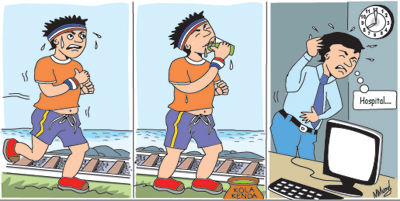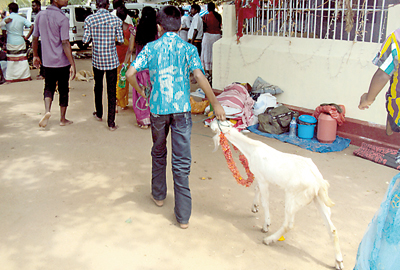Letters to the Editor
View(s):Marine Drive fitness folk may think they’re on the right health track
Travel along Marine Drive, between Wellawatte and Bambalapitiya, and you will see scores of people exercising. They walk, jog, stretch, and do all sorts of fat-burning exercises. They range from the very young and energetic to the elderly and feeble. At six in the morning you will see at least a hundred exercise enthusiasts doing their workout routines along Marine Drive.
Even little businesses have sprung up along the road to cater to the exercise fans. You have stalls that sell all manner of things from energy drinks and herbal porridge to snacks and newspapers. Colombo society appears to think it is on the right track in terms of health.

Now fast forward to evening, around 6 p.m. This is the hour when private hospitals in and around Colombo are packed with patients suffering from a variety of ailments, from the common cold to heart disease. Patients range from the rich to the poor and those struggling to make ends meet. It is no wonder the healthcare industry is enjoying a boom.How did a seemingly health-conscious society become so susceptible to disease?
The grim fact is all the aerobic exercises in the world cannot battle unhealthy lifestyles. Our ancestors built monumental structures with their bare hands, lifting boulders and putting in place mighty stone pillars. Most of us cannot bend over to pick up a newspaper without experiencing a twinge in the back. The difference is not in miracle pills or elixirs for longevity or New Age exercises – it’s a matter of lifestyle.
Our ancestors lived off the land, eating vegetables and fruit, while we stuff ourselves with fried chicken and calorific snacks. Our ancestors led active lives. They worked hard and were always occupied, while we sit in a chair and stare at a computer 10 to 12 hours a day and believe we are living healthily when we walk along Marine Drive in track shorts and stop to gulp down “kola kenda.”
The main difference is that our ancestors lived happy, relaxed and fulfilled lives, while most of us in the present context are dissatisfied or depressed.
Jayanka de Silva, Moratuwa
Give them a chance
A lot of noise is being made about the Malabe Medical School. The issue is the lack of a hospital for teaching medical students.
It should be pointed out that the Colombo Medical School was an outcome of the General Hospital, Colombo and not vice versa. It was a fee-levying institution and term fees had to be made in one payment. Students who passed the matriculation examination were invited by letter to join the school to follow the LMS (Licentiate in Medicine and Surgery). There was no guarantee of employment in the state medical service after you passed out.
Those who could afford it went to England to do the MBBS or LRCP, its equivalent at the time, and started their own practice. It was at this time that men of the calibre of Professors G. A. Wickramasuriya, W. A. Karunarathne, and Milroy Paul were produced, and their work was quoted in textbooks at the time.
When the North Colombo Medical College was started by a group of doctors, some professors sponsored a campaign to stop it, saying the students entering were not qualified to do medicine. When it was closed, students who could afford it went abroad. I know of one such student who is now a professor in an American university.
The same arguments are trotted out again to halt the Malabe venture. One argument is the qualifications of the teaching staff. This is something that can be rectified. Instead of giving a helping hand, people are throwing brickbats at the venture. Give it a chance to stand on its own feet and then pick holes when necessary. After all, the Colombo faculty has come a long way – 120 years – to be what it is.
Dr. Chandra Weeraratne, Ratmalana
Animal sacrifice is an ancient religious practice
A Minister has come out in protest over the sacrificing of animals, a religious right, perhaps to divert the attention of the masses from the country’s problems.
The Jathika Hela Urumaya (JHU) also has protested, saying animal sacrifice is against Buddhist beliefs. Strangely, the same JHU voted with the government to pass the Casino Bill, which, as any good Buddhist knows, is against all five precepts of the “Pancha Seela.”
The Constitution of Sri Lanka says: “Every person is entitled to freedom of thought, conscience and religion, including the freedom to have or adopt a religion or belief of his choice.”
Every religion, except Buddhism, advocates or practises the slaughter or sacrifice of animals. Those of the Islamic faith slaughter animals for human consumption after a religious rite is performed. Those who go on pilgrimage to Mecca sacrifice goats. The Bible is full of such sacrifices.
The majority of people in this country consume the meat of different animals, especially the flesh of cattle, chicken and fish.
G. A. D. Sirimal, Dehiwala
Who set the dress code for devotees to pay homage to sacred relics?
Did the Buddha stipulate that devotees should come dressed in white to pay homage to Buddha relics? True, white is pleasing to the eye, and it is standard practice to wear simple white clothing that sufficiently covers the body. But can anybody say that devotees must wear white to a place of worship, to participate in a pooja (ritual), or to attend a Buddhist monk’s funeral?
Recently, a family that missed the opportunity to pay homage to the Kapilawasthu Buddha relics exposition in Colombo travelled all the way from Panadura to Pellmadulla, only to be told by the organisers that the party could not join the long queue because two of them were dressed in non-white, pastel-hued clothes.
The party pleaded with the authorities, but were mistreated and subjected to rude remarks. After five hours of pleading, the group was finally allowed to join the queue.
This incident reminded me of a dire incident I experienced a few years ago, at the funeral of the Ven. Soma Thera.
I went straight from my office to the funeral venue at Independence Square. I parked my car opposite the Sinhalese Sports Club (SSC) grounds. A massive crowd had gathered in the precincts of Torrington. The popular Thera’s demise had caused turmoil among his followers, who had suspicions about the circumstances surrounding it.
When the pyre was set alight, an ugly scene followed. Youths in national dress started to assault a group that was distributing leaflets. The youths then turned on people who had come to the funeral dressed in coloured clothes. With difficulty, I made my way through the crowds and reached a safe area. I was wearing a light beige shirt. With the blessings of the Triple Gem I found my way to Maitland Place, where I had parked my car.
Will some learned monk or lay scholar of Buddhism enlighten us on the Buddha’s teachings on dress and coloured clothes?
Our Sunday school Dhamma teacher related the Patacharaa story about a distraught woman who had lost all her loved ones and all her possessions, all in a single day. She walked into the Jethawanarama, without even a piece of thread to cover her body.
When the priests tried to stop her from entering the revered dwelling of the Buddha, the Lord Buddha himself intervened and ordered that the woman be allowed to enter the temple.
K. K. S. Perera, Panadura
Follow @timesonlinelk
comments powered by Disqus


























